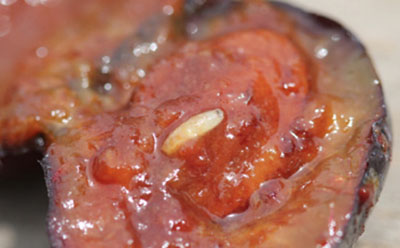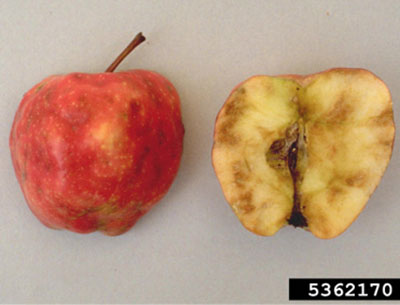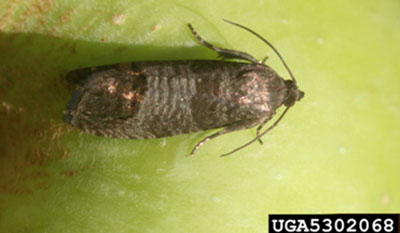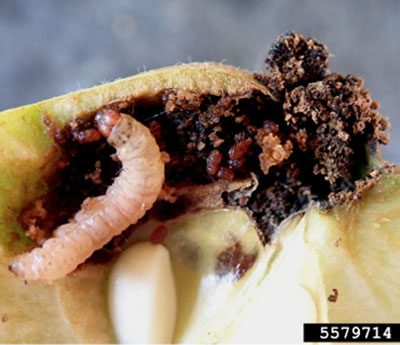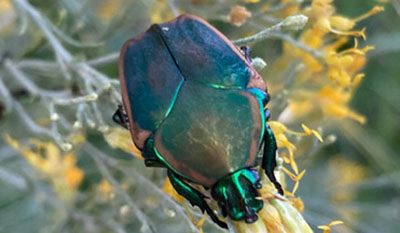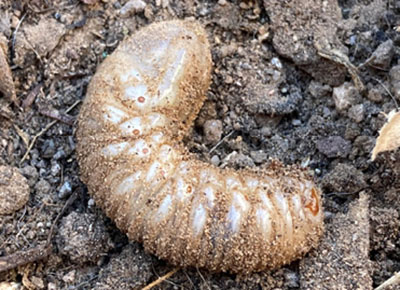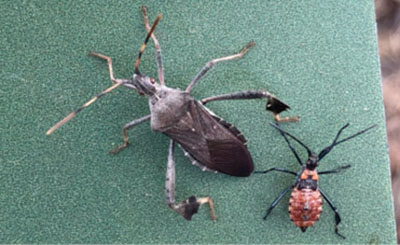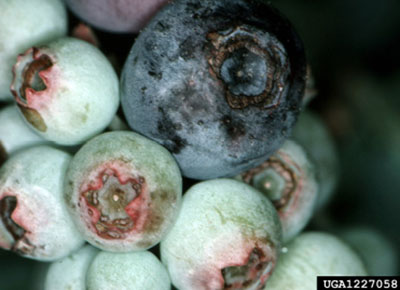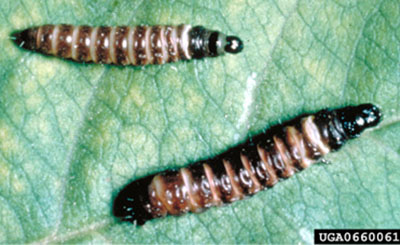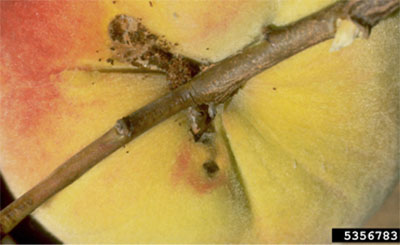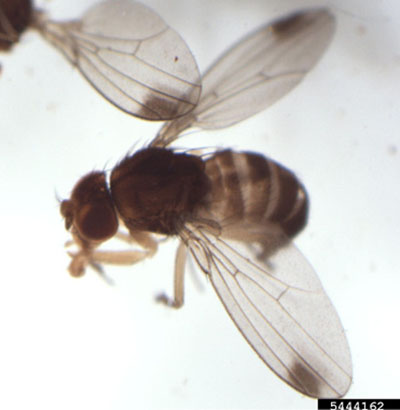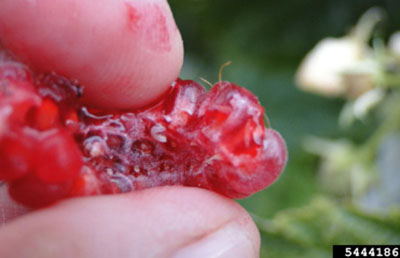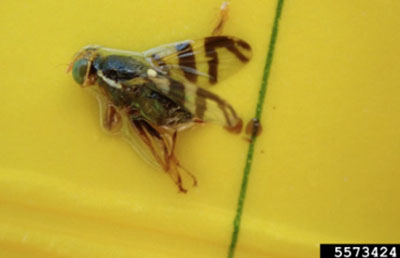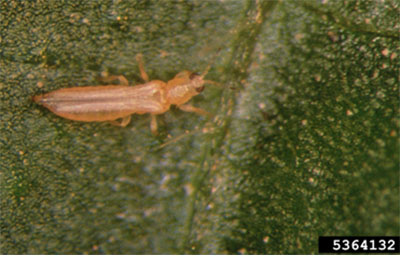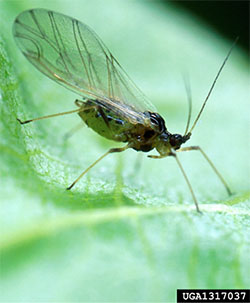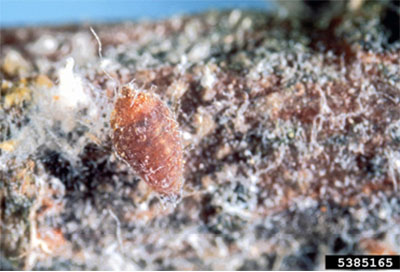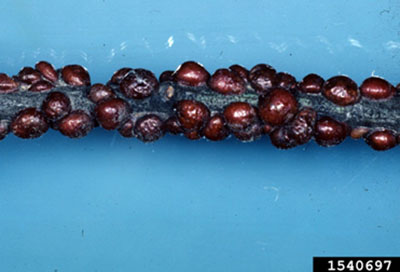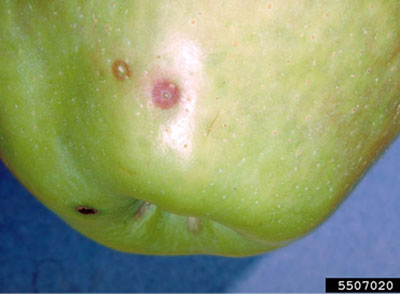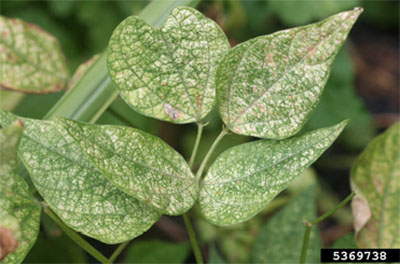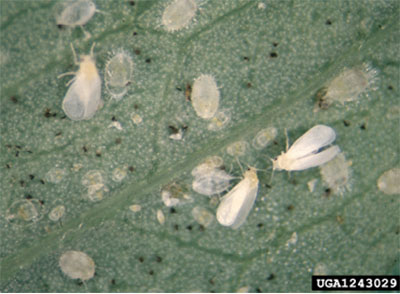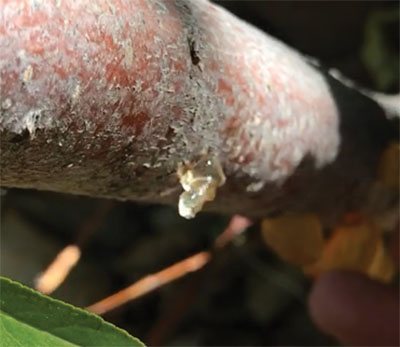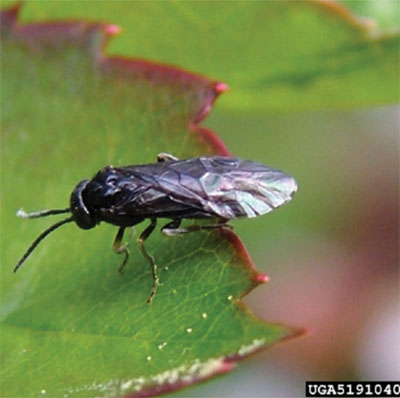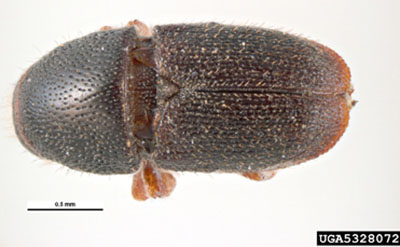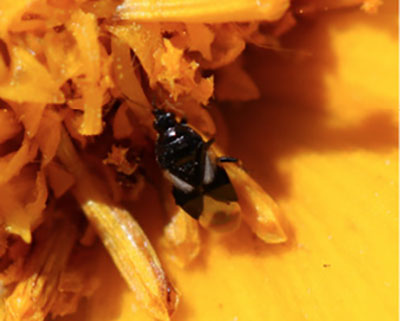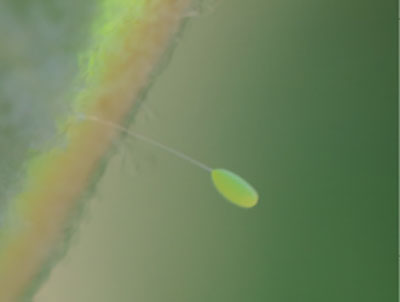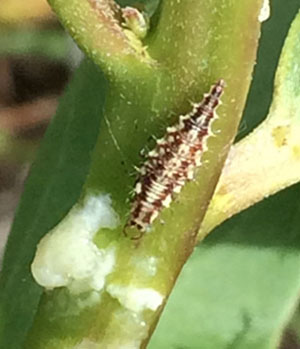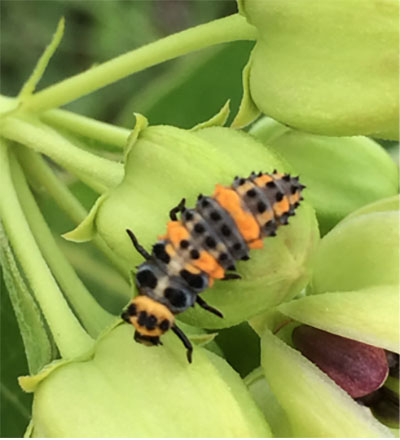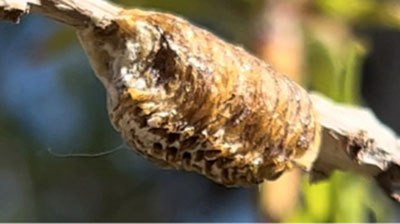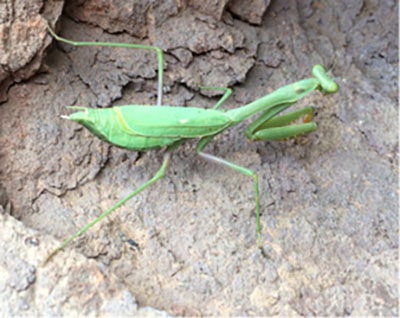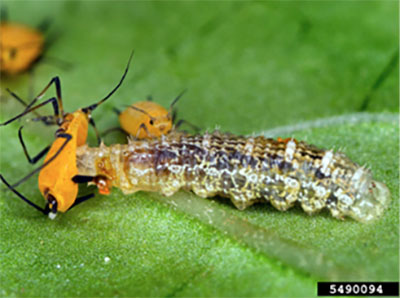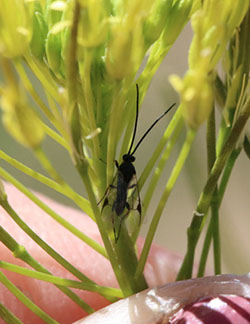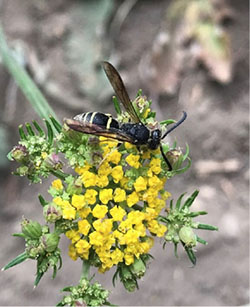Guide H-184
Miranda L. Kersten, Ashley R. Knoch, Marisa Y. Thompson*
Reviewed by Joanie King (November 2025), Assistant Professor and Extension Entomology Specialist, Entomology, Plant Pathology, and Weed Science
College of Agricultural, Consumer and Environmental Sciences, New Mexico State University
*Respectively, Program Manager, Agricultural Science Center at Los Lunas; Research Assistant, Agricultural Science Center at Los Lunas; Extension Urban Horticulture Specialist, Department of Extension Plant Sciences. (Print Friendly PDF)
Table of Contents
- Apple maggot (Rhagoletis pomonella, Figures 1A–1C)
- Codling moth (Cydia pomonella, Figures 2A and 2B)
- Green fruit beetle (Cotinis mutabilis, Figures 3A and 3B)
- Leaf-footed plant bug (Leptoglossus spp., Figures 4A and 4B)
- Peach twig borer (Anarsia lineatella, Figures 5A and 5B)
- Spotted wing drosophila (Drosophila suzukii, Figures 6A and 6B)
- Western cherry fruit fly (Rhagoletis indifferens, Figure 7)
- Western flower thrips (Frankliniella occidentalis, Figure 8)
- Aphids (Figures 9A–9C)
- European fruit lecanium (aka brown apricot scale; Parthenolecanium corni,
Figure 10) - San Jose scale (Quadraspidiotus perniciosus, Figure 11)
- Two-spotted spider mite (Tetranychus urticae, Figures 12A
and 12B) - Whiteflies (Figure 13)
- Peachtree borer (Synanthedon exitiosa, Figures 14A–14C)
- Pear slugs (aka cherry slugs, Caliroa cerasi, Figures 15A and 15B)
- Shothole borer (Scolytus rugulosus, Figures 16A and 16B)
- For Further Reading
- Select References
- Acknowledgment
Integrated Pest Management
Integrated pest management (IPM) is a sustainable approach to pest management that combines cultural, mechanical/physical, biological, and chemical control strategies to minimize economic, health, and environmental risks (USDA–ARS, 2018). The following steps are key to a successful IPM program when managing fruit trees and berries for insect pests. Some bold terms can be found in the glossary at the end of this guide.
- Prevention—Avoid insect pests through proper plant selection, planting techniques, maintenance, irrigation, and limited/careful fertilization.
- Monitoring—Regularly inspect your trees and plants for insect pests or signs of damage.
- Identification—Correctly identify both the plant species and insect pests present. Correct identification is critical for creating an effective IPM plan.
- Management—Select appropriate IPM strategies for the pest, including cultural, mechanical/physical, biological, and chemical management strategies. Below is a description of each strategy.
Cultural control strategies make the environment less suitable for pests.
Examples:
- Select species/cultivars that are tolerant or resistant to stressors, including pests, drought, disease, and heat or cold.
- Select a proper site for trees and plants in terms of soil, light, space, wind, and water.
- Keep trees and plants healthy to minimize stress and prevent pests.
- Water trees properly. Over-watering can kill roots, encourage weeds, and promote disease, while under-watering can cause drought stress and increase susceptibility to some pests.
- Remove weeds from the landscape to reduce overwintering habitat for pests.
Mechanical/physical control tactics use equipment or barriers to protect plants.
Examples:
- Insect pests can be removed by hand and destroyed.
- Trapping can be used to monitor pests and reduce their populations.
- A high-pressure stream of water can dislodge insects feeding on foliage or dislodge egg cases.
- A protective coating of paint on tree trunks can reduce sunscald (aka winter injury) and associated open wounds, thereby reducing the chance of attack from wood-boring insects.
- Sticky barriers applied to tree trunks can prevent crawling pests from reaching the upper parts of a tree.
Biological control methods use living organisms (natural enemies) to suppress pest populations. Two types of biological controls can be implemented in urban and agricultural landscapes: augmentation and conservation.
Augmentation biological control involves releases of insect predators or parasitoids to manipulate the natural enemy community. Many insect predators and parasitoids are available commercially and can be released to enhance natural pest suppression.
Conservation biological control encourages existing natural enemy populations through habitat management, including the following techniques:
- Incorporate flowering plants (floral resources) into the landscape that provide food and nesting resources to attract natural enemies.
- Provide floral resources from early spring to late fall to support and build effective natural enemy populations.
- Leave some perennial plants, leaves, and fallen logs to provide nesting and overwintering habitat for natural enemies.
- Avoid or limit pesticide use to protect natural enemy populations.
For more information on using floral resources to attract natural enemies, see NMSU Extension Guide H-169, Using Insectary Plants to Attract and Sustain Beneficial Insects for Biological Pest Control (https://pubs.nmsu.edu/_h/H169.pdf).
Chemical control uses synthetic and/or naturally derived compounds (i.e., pesticides) that kill, repel, regulate, or interrupt the growth of insect pests.
IPM strives to eliminate or reduce the use of chemical controls. When practicing IPM for fruit trees, use cultural, mechanical/physical, and biological controls before trying chemical controls. Specific chemicals are not recommended in this guide because product registrations change over time. If chemical controls are needed, follow these best management practices:
- Correctly identify the pest to select the best chemical control. If you are having difficulties with identification, contact your county Extension agent (https://extension.nmsu.edu/county.html) for assistance.
- Always read and follow chemical label instructions carefully.
- Apply chemical controls during the correct life stage because some insect life stages are more susceptible to insecticides than others.
- Apply chemical controls under the recommended wind speeds and temperatures.
- To slow the development of insecticide resistance, do not spray the same chemical consecutively, avoid using the same chemical family, and use the application rate on the label.
- In order to protect beneficial insects, do not spray when trees or shrubs are blooming.
- Select chemical controls that do not persist in the environment.
- Broad-spectrum applications are highly toxic to beneficial insects and should only be applied when flowers are no longer present.
- Use narrow-spectrum chemicals that target the pest but reduce impacts on natural enemies, e.g., Bt (Bacillus thuringiensis).
- Select chemical controls, such as horticultural oils and insecticidal soaps, that reduce non-target effects on natural enemies and other beneficial insects.
- Contact your county Extension agent to find products appropriate for your insect pest.
Insects That Harm Fruits
Apple maggot (Rhagoletis pomonella, Figures 1A–1C)
Figure 1A. Apple maggot larva in a plum (photo by Whitney Cranshaw, Colorado State University, Bugwood.org).
Figure 1B. Apple maggot adult (photo by Joseph Berger, Bugwood.org).
Figure 1C. Apple maggot damage (photo by H.J. Larsen, Bugwood.org).
Hosts: Apple, hawthorn, crabapple, pear
Biology and life cycle:
- Adults emerge in the summer and lay eggs under the fruit skin by late summer.
- After eggs hatch, maggots feed for 3–4 weeks and emerge from the fruit by
late fall. - Pupae overwinter underground in soil near infested trees for 1–2 years.
- One generation per year.
Metamorphosis: Complete
Overwintering stage: Pupa
ID tips:
- Adult flies are 1/4 inch long and have clear wings with black markings and three to four white stripes on their abdomen.
- Larvae are cream-colored and legless, but unlikely to be seen because they are inside the fruit.
- Pupae are smooth and pale yellow-brown.
- Sting (tiny dimple) found on fruit where egg is laid.
Damage:
• Larvae create tunnels inside fruit that lead to discoloration and rot.
• High infestations cause misshapen and distorted fruit that is inedible.
Damaging stage: Larva
IPM strategies:
- Monitor for adults using sticky traps or apple maggot traps (sticky red spheres that mimic apples and attract female flies). Check traps weekly during the growing season.
- Place bags around fruits on trees once they are 1/2–1 inch in diameter. This strategy is time- and labor-intensive and better suited for small- to medium-sized trees.
- Harvest fruits promptly and remove fallen and overripe apples.
- Apply kaolin clay to fruit, leaves, and branches to discourage egg-laying. Re-apply as fruits grow.
- Natural enemies are not considered effective in controlling apple maggot since larvae are hidden within fruit.
- Apply spinosad to prevent egg-laying. Insecticides should be used in conjunction with traps to determine timing of pesticide applications. Applications may be repeated if adults are still present.
Codling moth (Cydia pomonella, Figures 2A and 2B)
Figure 2A. Codling moth adult (photo by Whitney Cranshaw, Colorado State University, Bugwood.org).
Figure 2B. Damage from late-stage codling moth larva (photo by Whitney Cranshaw, Colorado State University, Bugwood.org).
Hosts: Apple, pear, quince, crabapple
Biology and life cycle:
- Moths emerge in the spring around bloom time and begin laying eggs on fruits and leaves.
- Six to 14 days later, eggs hatch and larvae burrow into the fruit until they reach the seeds where they feed.
- Full-grown larvae tunnel out of the fruit and pupate in debris or beneath the tree’s bark.
- Two to three generations per year.
Metamorphosis: Complete
Overwintering stage: Larva
ID tips:
- Adults are 1/2 inch long with gray or tan coloration and small alternating bands of white on the wings.
- Males have shiny, copper-colored scales at the ends of their wings.
- Larvae grow to about 1/2 inch long and have a yellow to tan body and a dark head.
- Stings (tiny dimples) occur where larvae bore into the fruit skin but then exit or die before causing deep tissue damage.
- Deep entries occur when larvae bore into the core of the fruit and feed in the seed cavity. Fruit can have multiple entry and exit holes. Brown frass may be found on the surface.
Damage:
- Feeding by larvae makes the fruit unsuitable for eating.
- Boring can introduce fungi and/or bacteria that can cause fruit to rot.
- Infested fruits may drop onto the ground.
Damaging stage: Larva
IPM strategies:
- Monitor for stings and other signs of damage.
- Pheromone traps can be used to monitor moth activity.
- Remove and destroy both fallen and infested fruit.
- Thin fruits to prevent fruits from touching each other (a common point of entry for larvae).
- Bag fruits when they are 1/2–1 inch in diameter.
- Band tree trunks with sticky bands, cardboard, or burlap to trap larvae emerging from soil. Frequently monitor the traps. Remove banding material and destroy larvae.
- Several generalist predators, such as minute pirate bugs, green lacewing larvae, spiders, and ground beetles, are natural enemies of codling moths.
- Trichogramma spp., ichneumonid, and braconid wasps use codling moth eggs or larvae as hosts.
- Insecticides are only effective if larvae are killed before they enter the fruit. Broad-spectrum insecticides, such as spinosad, may be used for codling moth control.
- Horticultural oils can be applied before eggs hatch to reduce larvae populations.
Green fruit beetle (Cotinis mutabilis, Figures 3A and 3B)
Figure 3A. Green fruit beetles feed on pollen in addition to ripe fruits (photo by Miranda Kersten, NMSU).
Figure 3B. Grubs live in the soil and can be found in compost piles (photo by Miranda Kersten, NMSU).
Hosts: Apricot, peach, plum, grape
Biology and life cycle:
- Grubs (larvae) live in soil, feeding on decomposing
organic matter. - Grubs pupate in the soil under grass and emerge as adults after 2–3 weeks in early summer.
- Adults are active in summer and feed on a variety of ripe fruits.
- Larvae overwinter in soil.
- One generation per year.
Metamorphosis: Complete
Overwintering stage: Larva
ID tips:
- Adults have a metallic green body, about 3/4–1 1/4 inches long, with a tan band along the outer edge of the elytra.
- Grubs are creamy white, up to 2 inches long, and curl into a C-shape when disturbed.
- Often confused with Japanese beetles. Green fruit beetles are usually larger than the Japanese beetle and do not have white spots on the abdomen.
Damage: Adults attack and feed on ripening fruit, causing damage to fruit skins.
Damaging stage: Adult
IPM strategies:
- Manage grubs by removing leaf litter and decaying organic materials near fruit trees.
- Turn over compost piles to expose grubs and crush if found.
- Remove fallen fruit.
- Traps can be used but may have the unwanted effect of attracting more beetles to the area.
- Insecticides are not recommended since green fruit beetles attack ripe fruits.
Leaf-footed plant bug (Leptoglossus spp., Figures 4A and 4B)
Figure 4A. Immature (nymph, right) and adult leaf-footed plant bugs (photo by Miranda Kersten, NMSU).
Figure 4B. Example of feeding damage from leaf-footed plant bugs on blueberry (photo by Jerry A. Payne, USDA Agricultural Research Service, Bugwood.org).
Hosts: Fruit trees, nut trees, ornamentals
Biology and life cycle:
- In spring, adults feed on seeds and later move to fruits to lay eggs.
- Nymph and adult stages may be seen together during the summer.
- Adults overwinter and aggregate in protected areas.
- Two to three generations per year.
Metamorphosis: Incomplete
Overwintering stage: Adult
ID tips:
- Adults are brown with a white zigzag pattern across mid-wing, 3/4–1 inch long, and have a distinct leaf-shaped protrusion on lower leg.
- Brown eggs are laid in a chain along the plant stem or middle of leaf.
Damage:
- Nymphs and adults feed on leaves, shoots, and fruits, forming “cat-faces” (blemishes or scars) on fruits that can cause unripe fruits and nuts to drop.
- Puncture wounds on fruits may excrete sap.
Damaging stage: Nymph and adult
IPM strategies:
- Depending on the crop, row covers can be used to physically exclude leaf-footed plant bugs from plants.
- Monitor for egg masses by checking on undersides of leaves.
- Remove overwintering sites, such as woodpiles.
- Remove or mow early spring weeds that provide adults with a food source when fruits are not available.
- Remove by hand and crush (wear gloves to protect hands from the odor they emit), or drop into soapy water. Destroy eggs if found.
- Egg parasitoids, tachinid flies, assassin bugs, predatory stink bugs, spiders, and birds all feed on leaf-footed bugs.
- Insecticides are often unnecessary but, if used, should target small nymphs.
Peach twig borer (Anarsia lineatella, Figures 5A and 5B)
Figure 5A. Peach twig borer larvae (photo by H. Audemard, INRA, Montfavet, Bugwood.org).
Figure 5B. Peach twig borer damage and frass on fruit (photo by Eugene E. Nelson, Bugwood.org).
Hosts: Peach, apricot, plum, nectarine
Biology and life cycle:
- Larvae overwinter in a hibernaculum (protective covering) in crotch of tree branch.
- Larvae emerge during bloom and initially feed on young leaves and buds and then bore into shoots, causing them to wilt. Later generations bore into fruit.
- Moths emerge in the spring.
- At least three generations per year.
Metamorphosis: Complete
Overwintering stage: Larva
ID tips:
- Adult moths are less than 1/2 inch long, and have gray mottled wings and a pointed head.
- Yellow to orange oval-shaped eggs are laid on young shoots, undersides of leaves, and developing fruits.
- Early instar larvae have light brown rings on body and a black head. Later instars are a darker brown and grow up to 1/2 inch.
Damage:
- Early generations bore into new shoots, killing them and causing leaves to wilt.
- Later generations feed on the fruit and leave exit holes.
- Repeated terminal branch death can stunt tree growth.
Damaging stage: Larva
IPM strategies:
- Look for wilted shoots in the spring.
- Pheromone traps can be used to monitor moths and help with timing of chemical treatments.
- Prune and destroy infested shoots.
- Many natural enemies help to control populations.
- Apply Bt or spinosad when larvae are first active or their damage has been observed and before they have entered plants.
Spotted wing drosophila (Drosophila suzukii, Figures 6A and 6B)
Figure 6A. Male spotted wing drosophila (photo by Hannah Burrack, North Carolina State University, Bugwood.org).
Figure 6B. Spotted wing drosophila larvae (photo by Hannah Burrack, North Carolina State University, Bugwood.org).
Hosts: Cherry, chokecherry, berries
Note: This species was first documented in north-central New Mexico in 2013, but has not become established (Grasswitz, 2015).
Biology and life cycle:
- Females cut a slit into ripening fruit and lay eggs within fruit.
- Larvae feed inside fruit for about a week.
- Larvae either pupate within the fruit or move to a protected location to pupate.
- Undergo several generations annually.
Metamorphosis: Complete
Overwintering stage: Adult
ID tips:
- A white thread on fruit indicates the presence of eggs.
- Adults have red eyes and tan bodies, less than 1/10 inch long. Males have a dark spot on their wings.
Note: Other Drosophila species feed on overripe or damaged fruit in New Mexico, so it is important to identify which species you have found.
Damage:
- Larvae feed inside fruit and cut holes into the sides of
the fruit. - Infected fruits become soft, may decay, and are unusable.
Damaging stage: Larva
IPM strategies:
- Monitor using commercial or homemade traps. Liquid or sticky traps can be used.
- Harvest ripe fruit regularly. Remove and destroy damaged fruits.
- Cover fruits with fine mesh before they begin to ripen.
- Many generalist predators feed on spotted wing drosophila.
- Chemical controls are considered preventive. Applications must cover the entire fruit.
Western cherry fruit fly (Rhagoletis indifferens, Figure 7)
Figure 7. Western cherry fruit fly on a yellow sticky trap (photo by Whitney Cranshaw, Colorado State University, Bugwood.org).
Host: Cherry
Biology and life cycle:
- Pupae overwinter in the soil. Some pupae remain dormant in the soil for several years before emerging.
- Adults emerge during late spring/early summer.
- Females puncture the skin of the developing cherry and lay eggs within. One female can lay about 50–200 eggs, with each egg laid in a single cherry.
- Larvae feed on the insides of the fruit. They then bore out of the fruit, fall to the ground, and burrow into the soil to pupate.
- One generation per year.
Overwintering stage: Pupa
ID tips:
- Adults have black bodies, thin white stripes across the abdomen, yellow markings on the thorax, and are about 1/5 inch long. Wings have a distinct black banding.
- Larvae are white, maggot-like, and found within the cherry.
Damage:
- Larvae develop inside cherries and eat fruit flesh.
- High populations can ruin almost all the fruit on the trees, but it is difficult to determine whether fruit is infested until the larvae emerge through a chewed hole in the cherry.
Damaging stage: Larva
IPM strategies:
- Place yellow sticky traps out in sunny areas when cherries are light green. Check daily until flies are seen.
- Ground barriers such as mulch and fabrics can reduce the western cherry fruit fly’s ability to pupate in the soil and emerge.
- Remove fallen fruits.
- Chemical controls should target the adult stage.
Western flower thrips (Frankliniella occidentalis, Figure 8)
Figure 8. Adult western flower thrip (photo by Frank Peairs, Colorado State University, Bugwood.org).
Hosts: Nectarine, apple, plum, apricot
Biology and life cycle:
- Females lay eggs in plant tissue.
- Larvae feed on very young fruits on the flower parts.
- Larvae and adults feed on pollen, nectar, and plant tissue.
- Adults overwinter on the ground.
- Multiple generations per year.
Metamorphosis: Incomplete
Overwintering stage: Adult
ID tips:
- Adults have a yellow to brown tubular-shaped body 1/25 inch long, with fringed wings.
- Immature thrips have more elongated bodies than leafhoppers.
Damage:
- Feeding causes net-like scarring or russeting on fruits.
- Oviposition scars (pansy spots) form on apples.
Damaging stage: Larva and adult
IPM strategies:
- Monitor for thrips as flowers form.
- Remove weeds from under trees and adjacent areas where western flower thrips overwinter.
- Minute pirate bugs prey on western flower thrips.
- Broad-spectrum insecticides are ineffective against western flower thrips and may instead help their populations by killing their natural enemies.
Insects That Suck Plant Fluids
Aphids (Figures 9A–9C)
Figure 9A. Green peach aphid (Myzus persicae) (photo by Scott Bauer, USDA Agricultural Research Service, Bugwood.org).
Figure 9B. Rosy apple aphid (Dysaphis piantaginea) (photo by Whitney Cranshaw, Colorado State University, Bugwood.org).
Figure 9C. Woolly apple aphid (Eriosoma lanigerum) (photo by Jeffrey W. Lotz, Florida Department of Agriculture and Consumer Services, Bugwood.org).
Examples of aphid pests that occur on fruit trees in New Mexico include green peach aphid (Myzus persicae), leaf curl plum aphid (Brachycaudus helichrysi) rosy apple aphid (Dysaphis piantaginea), and woolly apple aphid (Eriosoma lanigerum).
Hosts: Peach, nectarine, apple, plum, most other plants
Biology and life cycle:
- Aphids often overwinter on primary host, which varies by species (green peach aphid and leaf curl aphid: Prunus spp.; rosy apple aphid: apple; woolly apple aphid: elm).
- Eggs hatch in early spring, and nymphs and adults feed on primary host.
- Most aphids are wingless, but winged aphids are produced to migrate to other host plants.
- In late spring or early summer, winged adults move to secondary hosts (green peach aphid: vegetables and ornamentals; rosy apple aphid: plantain; woolly apple aphid: apples).
- Winged adults are produced again in the fall and move back to primary host plants to lay overwintering eggs.
- Females are parthenogenic, which means they can give birth to live young that have developed from unfertilized egg cells.
Metamorphosis: Incomplete
Overwintering stage: Egg (woolly apple aphids also overwinter as adult)
ID tips:
- Aphids have pear-shaped, soft bodies that are 1/10–1/3 inch long. Coloration varies among species; green peach aphids are pale green, rosy apple aphids are a waxy purple, and woolly apple aphids are reddish-brown but covered with a white, cotton-like, waxy substance.
- Yellowing leaves can be a sign that woolly apple aphids have infested tree roots.
Damage:
- Green peach aphids cause leaves to wilt, which can reduce plant growth. They can also vector plant viruses.
- Rosy apple aphids cause leaves to curl and shoots to be deformed. Feeding near leaves of fruit clusters causes apples to be smaller and misshapen.
- Feeding by woolly apple aphids causes galls to form on twigs, branches, and roots.
- Aphids excrete honeydew, which can lead to growth of sooty mold that can grow as black areas on leaves and fruit. The honeydew can also attract ants, which will protect the aphids by preventing natural enemies from feeding on them.
Damaging stage: Nymph and adult
IPM strategies:
- Monitor plants for aphids. Check pruning scars on apple trees for the presence of woolly apple aphids. Look for live aphids under the waxy residue.
- Rinse aphids off plants with a high-pressure stream of water.
- Apply sticky tape to base of tree to prevent ants from protecting aphids.
- Generalist predators, such as lady beetle larvae, green lacewings, syrphid flies, praying mantids, and parasitoid wasps, help to control aphid populations.
- Chemical options exist for aphids, but care should be taken to protect predators. No chemical control options are available for underground infestations of woolly apple aphid.
- Check to see if ants are tending aphids. If so, ants may also need to be controlled to effectively reduce aphid populations. Control ants by physically blocking their access to aphids with sticky barriers.
European fruit lecanium (aka brown apricot scale; Parthenolecanium corni, Figure 10)
Figure 10. European fruit lecanium (photo by Lacy L. Hyche, Auburn University, Bugwood.org).
Hosts: Apricot, grape, plum, pecan
Biology and life cycle:
- Nymphs overwinter on twigs and small branches.
- Female scales attach to undersides of twigs.
- Females lay eggs under their cover in late spring and then die.
- Crawlers (mobile nymph stage) feed on leaves in the summer and fall and produce large amounts of honeydew.
- One generation per year.
Metamorphosis: Incomplete
Overwintering stage: Nymph
ID tips:
- Adult females are shiny reddish-brown, rounded with a ridged back, about 1/8–1/4 inch long.
- Crawlers are dark yellow to brown and very small (3/64 inch).
- Nymphs are tiny, round, flattened, dark yellow to brown.
Damage:
- Scales produce honeydew, which can attract ants and lead to sooty mold growth that can cause blackened areas on leaves and fruit.
- High populations can cause twig dieback.
Damaging stage: Nymph and adult
IPM strategies:
- Look for nymphs on previous year’s growth.
- Lady beetles, lacewings, and parasitoid wasps target the crawler stage. Parasitized nymphs are blackish and round.
- Chemical controls should be timed for when crawlers are active.
- Dormant horticultural oils can be applied in the spring to manage overwintering nymphs.
San Jose scale (Quadraspidiotus perniciosus, Figure 11)
Figure 11. San Jose scale on apple (photo by Phil Sloderbeck, Kansas State University, Bugwood.org).
Hosts: Apple, cherry, pear, peach, other fruit and nut trees
Biology and life cycle:
- Females remain under scale covering and give birth to live young, which emerge in the spring.
- After crawlers settle and begin feeding, they cover themselves with a white, waxy material and enter the “white cap” stage.
- The waxy covering eventually turns black, and nymphs overwinter in this “black cap” stage and resume growing in late winter.
- Generally four generations per year in New Mexico.
Metamorphosis: Incomplete
Overwintering stage: Nymph
ID tips:
- San Jose scales can be distinguished from other scale insects by the red spots that form on fruits from feeding.
- Nymphs are bright yellow and very small (1/100 inch).
- Adult females have gray, rounded scale coverings up to 1/12 inch in diameter, and are wingless. Adult males are winged, have long antennae, and are about 1/25 inch long.
Damage:
- A reddish-purple ring forms on the fruit around the scale.
- San Jose scales suck sap from branches, leaves, and fruit, which reduces plant growth and yield.
Damaging stage: Adult (female) and nymph
IPM strategies:
- Check fruit for scales.
- Use a high-pressure stream of water to remove scale insects from plants.
- Lady beetles, lacewings, parasitoid wasps, and some birds, such as nuthatches and brown creepers, attack San Jose scale.
- Insecticides and insecticidal soaps can be used, but applications should target crawlers.
For more information on monitoring and treating San Jose scale with insecticides, see NMSU Extension Guide H-428, San Jose Scale, (Quadraspidiotus perniciosus) and Its Control (https://pubs.nmsu.edu/_h/H428.pdf).
Two-spotted spider mite (Tetranychus urticae, Figures 12A and 12B)
Figure 12A. Two-spotted spider mite (photo by David Cappaert, Bugwood.org).
Figure 12B. Leaf damage caused by two-spotted spider mites (photo by Whitney Cranshaw, Colorado State University, Bugwood.org).
Hosts: Apple, peach, nectarine, cherry, plum, other ornamental trees and plants
Biology and life cycle:
- Spider mites overwinter as adults in leaf litter or under bark.
- Eggs are laid on the undersides of leaves in the spring.
- Their life cycle can take one to three weeks to complete, depending on temperatures.
- Spider mites thrive in hot, dusty environments.
- Undergo multiple, overlapping generations annually.
Metamorphosis: None
Overwintering stage: Adult
ID tips:
- Use a hand lens (10–15× magnification) to check for tiny moving dots (1/60 inch) on the undersides of leaves.
- Spider mites have an oval body shape with two dark spots on the front of their body.
- Check for presence of webbing on leaves.
Damage:
- Feeding causes yellow stippling on leaves.
- High infestations can cause necrosis on leaves.
Damaging stage: Nymph and adult
IPM strategies:
- Keep trees well-watered.
- Wash dust off trees using a strong stream of water.
- Predatory mites, predatory thrips, and many other generalist predators feed on two-spotted spider mites.
- Insecticidal soaps and horticultural oils can be applied when mites first appear.
Whiteflies (Figure 13)
Figure 13. Multiple life stages of greenhouse whitefly (photo by Whitney Cranshaw, Colorado State University, Bugwood.org).
Hosts: Ornamental trees, fruit trees, ash trees
Biology and life cycle:
- Pale yellow, waxy eggs are laid on the undersides of leaves.
- Nymphs are opaque and become covered in white wax as they develop.
- Whiteflies form a “pupal case” that has tubercles around the edges that produce clear liquid droplets.
- While whiteflies feed on deciduous hosts, they tend to overwinter on evergreens.
- Several generations per year are possible, with more generations occurring in warmer climates.
Metamorphosis: Incomplete
Overwintering stage: All stages
ID tips:
- Adults have light-colored bodies with white wings that have a waxy appearance, and resemble small moths.
- Females are about 1/15 inch in size and leave waxy white circles on leaves surrounding eggs.
Damage:
- Feeding by nymphs and adults causes leaves to wilt and curl at the tips.
- Heavy feeding can cause leaves to drop as well as loss of smaller fruits in fruit trees.
- Whiteflies secrete honeydew that can cause the growth of sooty mold and attract ants.
Damaging stage: Nymph and adult
IPM strategies:
- Place yellow or white sticky traps near plants to monitor populations.
- Check leaves for whiteflies, especially near areas with honeydew or
sooty mold. - Remove infested leaves.
- Dislodge adults from plants using a high-pressure stream of water.
- Control ants that feed on honeydew and help to protect whiteflies from predators.
- Parasitoid wasps, lady beetles, green lacewings, big-eyed bugs, and minute pirate bugs attack whiteflies.
- Insecticidal soaps, neem oil, and petroleum-based oils can be effective but require direct contact with the pest.
Insects That Chew
Peachtree borer (Synanthedon exitiosa, Figures 14A–14C)
Figure 14A. Peachtree borer larva found inside a peach tree (Prunus persica) (photo by Whitney Cranshaw, Colorado State University, Bugwood.org).
Figure 14B. Male and female peachtree borer moths (female on right) (photo by Joseph Berger, Bugwood.org).
Figure 14C. Gummosis found along the trunk of Prunus sp. (photo by Marisa Thompson, NMSU).
Hosts: Peach, plum, apricot, cherry, other stone fruits
Biology and life cycle:
- Moths emerge during the summer and immediately lay eggs in lower trunk bark or within soil cracks.
- Larvae bore into cracks in the bark or through wound openings and feed on sapwood until cold weather arrives.
- Larvae overwinter underground and begin feeding again as the weather warms. They pupate near the base of the tree.
Metamorphosis: Complete
Overwintering stage: Larva
ID tips:
- Adults are diurnal (active during the day), have a wasp-like body with clear wings, and are about 1 1/4 inch long.
- Brown pupal cases can sometimes be found at base of tree.
- Gummosis (balls of sap) often found on the trunk or around the base of a tree where borers were active.
Damaging stage: Larva
Damage:
- Larvae feed on bark, which damages the trunk, lower limbs, and roots and may result in tree death.
IPM strategies:
- Stressed and young trees are more susceptible to damage from borers.
- Avoid mulching up to the base of the tree.
- Avoid tree damage from weed eater or mower.
- Maintain tree health through proper watering, pruning, and fertilization.
- Place pheromone traps in the spring to monitor for adults, and leave them up throughout the growing season to reduce populations.
- Predators include ants, green lacewing larvae, and spiders. Parasitoid wasps attack the egg, larval, and pupal stages.
- Pesticide applications are considered preventive since they only target the egg and early larval stage.
- Apply neem oil to the base of the trunk to suppress eggs and prevent early larval stages from developing and boring into the tree.
Pear slugs (aka cherry slugs, Caliroa cerasi, Figures 15A and 15B)
Figure 15A. Pear slugs on a leaf (photo by Lesley Ingram, Bugwood.org).
Figure 15B. Adult pear sawfly (photo by Cheryl Moorehead, Bugwood.org).
Hosts: Cherry, plum
Biology and life cycle:
- Adults cut slits into leaf and lay eggs within the leaf during late spring.
- Larvae feed on the leaf surface during summer.
- Pupae overwinter underground.
- Two generations per year.
Metamorphosis: Complete
Overwintering stage: Pupa
ID tips:
- Adults are dark-colored sawflies, about 1/4 inch long.
- Larvae resemble slimy caterpillars, grow to 1/2 inch long, and range from dark green to orange in color.
- Eggs are tan, oval, and may look like small blisters.
Damage:
- Larvae skeletonize leaves.
- Feeding causes leaves to turn brown and drop prematurely if heavily damaged.
Damaging stage: Larva
IPM strategies:
- Monitor for pear slugs in the late summer when populations are large enough to cause significant defoliation.
- Healthy trees can withstand some defoliation.
- Remove pear slugs by hand or dislodge using a high-pressure stream of water.
- Although exact natural enemies are unknown, they often keep pear slug populations in check.
- Several chemical options exist for pear slug control, including horticultural oils, neem oil, insecticidal soap, and spinosad. Check labels for application rates.
Shothole borer (Scolytus rugulosus, Figures 16A and 16B)
Figure 16A. Shothole borer damage (photo by Clemson University–USDA Cooperative Extension Slide Series, Bugwood.org).
Figure 16B. Shothole borer (photo by Pest and Diseases Image Library, Bugwood.org).
Hosts: Apple, cherry, peach, plum
Biology and life cycle:
- Adults emerge from host trees in spring, leaving exit holes in bark, and then fly to other distressed trees.
- Adult females chew burrows parallel to the wood grain,
laying eggs along the resulting gallery (tunnel). - Larvae hatch and chew through wood perpendicular to the grain, feeding on the phloem.
- Pupate under bark by fall.
- One generation per year.
Metamorphosis: Complete
Overwintering stage: Larva or pupa
ID tips:
- Adults are small (1/10 inch) gray-black beetles.
- Small, round exit holes (1/16 inch) in bark are a characteristic of this insect.
- Sap (aka gummosis) oozing from entry or exit holes.
Damage:
- Feeding by larvae girdles the tree, which weakens or kills branches or
entire trees.
Damaging stage: Larva
IPM strategies:
- Keep trees healthy and actively growing—shothole borers target diseased or weakened trees.
- Prevent sunscald by painting the trunk with a 50:50 mix of white latex paint and water.
- Remove and destroy infested trees and branches in winter.
- Prune dying and dead branches.
- Natural enemies of shothole borers include woodpeckers, checkered beetles, and parasitoid wasps.
- Insecticides are not effective in controlling shothole borers.
Natural Enemies
Natural enemies can help suppress pest populations. To help conserve and increase natural enemies, add floral resources to the landscape and make sure pollen and nectar are available throughout the growing season. Figures 17–23 show examples of natural enemies that are commonly found in New Mexico.
Figure 17. Minute pirate bugs are predators of insect eggs and many soft-bodied insects (photo by Miranda Kersten, NMSU).
Figure 18A. Lacewing eggs are laid on a stalk and are often found near their insect prey (photo by Miranda Kersten, NMSU).
Figure 18B. Lacewing larvae consume soft-bodied insects and insect eggs (photo by Miranda Kersten, NMSU).
Figure 19. Lady beetle larvae (shown here) and adults are predators of many insect pests (photo by Miranda Kersten, NMSU).
Figure 20A. Praying mantids overwinter in their egg case (ootheca, shown here) (photo by Marisa Thompson, NMSU).
Figure 20B. Praying mantids eat a variety of insects (photo by Miranda Kersten, NMSU).
Figure 22. Parasitoid wasps infect the egg, larval, or pupal stage of their insect hosts (photo by Miranda Kersten, NMSU).
Figure 21. Syrphid fly larvae feed on soft-bodied insects, such as aphids (photo by David Cappaert, Bugwood.org).
Figure 23. Wasps are carnivorous, but will supplement their diet with nectar (photo by Miranda Kersten, NMSU).
Glossary
Beneficial insects: Insects that perform ecosystem services, such as pollination and pest suppression. This includes pollinators and natural enemies (predators, parasitoids, and pathogens).
Bt: Bacillus thuringiensis, a species of bacteria commonly used as a biological pesticide.
Complete metamorphosis: Developmental process in which an insect undergoes four life stages—egg, larva, pupa, and adult. Each stage looks distinctly different from the previous stage.
Elytra: A hard protective covering (modified front wings) over the hind wings, such as on lady beetles.
Frass: Waste produced by an insect that may look like sawdust.
Gummosis: Sap oozing from wounds or cankers on fruit trees that resembles a gummy substance. Typically, this is caused by insect problems, climatic conditions, infections, or mechanical damage.
Honeydew: A sweet, sticky substance excreted by certain insects, such as aphids.
Incomplete metamorphosis: Developmental process in which an insect undergoes three life stages—egg, nymph, and adult. The nymph and adult stages resemble each other. Adults are typically larger than nymphs and may have wings.
Instar: Larval or nymph growth stages that are separated by molting.
Larva (plural larvae): The immature stage of an insect. The larval stage of moths and butterflies is a caterpillar, and is a grub in beetles.
Metamorphosis: The developmental process of living organisms; in insects, metamorphosis can be complete or incomplete.
Natural enemies: Predators, parasitoids, and pathogens that are beneficial because they reduce the numbers of pest insects by killing them or limiting their reproductive success.
Nymph: An immature stage of an insect that resembles its adult form.
Ovipositor: An organ with which a female insect lays eggs.
Parasitoids: Insects whose larval stage lives within an insect host. Eventually, the larval stage emerges and kills the host, and the adult stage will lay eggs on or within a new host insect.
Predators: Animals, including insects and other arthropods, that feed on insect prey throughout their life. Many of these predators would be considered beneficial natural enemies.
Pupa (plural pupae): The developmental stage of insects in which the insect transitions from a larva to an adult; the pupal stage may be protected by a structure, such as a cocoon.
Skeletonization: Damage to the leaf caused by insects that feed between the veins and leave behind the leaf veins.
Stings: Entry holes (tiny dimples) in fruit made by larvae tunneling into fruit.
Stippling: Leaf damage that appears as small, discolored spots, caused by feeding by sap-sucking insects.
Tubercles: Structures found on the pupal case of ash whiteflies that produce clear waxy droplets.
Vector: To carry or transmit a pathogen to another organism.
Resources
Plant diagnostic services are available for New Mexico residents through the NMSU Plant Diagnostic Clinic (https://plantclinic.nmsu.edu/). Bring samples to the nearest NMSU Cooperative Extension Service office to be sent to the NMSU Plant Diagnostic Clinic for free services, including analysis of plant material for pathogens, pests, and environmental stresses. Find your local Extension office at https://extension.nmsu.edu/county.html, and learn more about submitting plant samples in NMSU Extension Guide H-158, How to Collect and Send Plant Specimens for Disease Diagnosis (https://pubs.nmsu.edu/_h/H158.pdf).
For Further Reading
Circular 655: Integrated Pest Management (IPM) for Home Gardeners
https://pubs.nmsu.edu/_circulars/CR655.pdf
Circular 607: Guide to the Biological Control of Some Common Yard and Garden Pest Insects in New Mexico
https://pubs.nmsu.edu/_circulars/CR607.pdf
Guide H-168: Selection and Use of Insecticides for Organic Production
https://pubs.nmsu.edu/_h/H168.pdf
H-169: Using Insectary Plants to Attract and Sustain Beneficial Insects for Biological Pest Control
https://pubs.nmsu.edu/_h/H169/index.html
H-174: Integrated Pest Management (IPM) Strategies for Common Insect Pests of Trees in New Mexico
https://pubs.nmsu.edu/_h/H174/index.html
H-176: Integrated Pest Management (IPM) Strategies for Common Garden Insect Pests of New Mexico
https://pubs.nmsu.edu/_h/H176/index.html
H-181: Integrated Pest Management (IPM) for Pollinator Conservation in Home Gardens and Small Farms
https://pubs.nmsu.edu/_h/H181/index.html
Select References
Frank, D.L. 2018. Evaluation of fruit bagging as a pest management option for direct pests of apple. Insects, 9(4), 178.
Grasswitz, T.R. 2015. First occurrence of spotted wing drosophila, Drosophila suzukii, in New Mexico, with notes on its host plant associations. Southwestern Entomologist, 40(4), 851–853.
Grasswitz, T.R., and S. Yao. 2016. Efficacy of pheromonal control of peachtree borer (Synanthedon exitiosa (Say)) in small-scale orchards. Journal of Applied Entomology, 140(9), 669–676.
Acknowledgment
This work is supported by the Crop Protection and Pest Management Program (grant no. 2021-70006-35765) project accession no. 1027442 from the National Institute of Food and Agriculture.
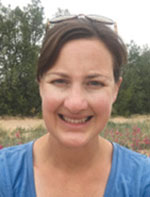
Miranda Kersten is a Program Manager with the urban integrated pest management (IPM) program at NMSU’s Agricultural Science Center in Los Lunas. Her work focuses on pollinator and beneficial insect conservation, monitoring beneficial insects across urban landscapes, and managing IPM research projects.
To find more resources for your business, home, or family, visit the College of Agricultural, Consumer and Environmental Sciences on the World Wide Web at pubs.nmsu.edu.
Contents of publications may be freely reproduced, with an appropriate citation, for educational purposes. All other rights reserved. For permission to use publications for other purposes, contact pubs@nmsu.edu or the authors listed on the publication.
New Mexico State University is an equal opportunity employer and educator. NMSU and the U.S. Department of Agriculture cooperating.
Revised November 2025, Las Cruces, NM


